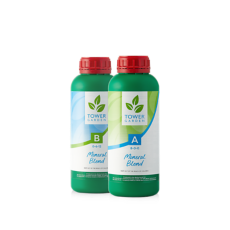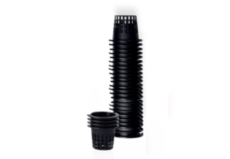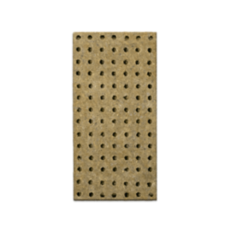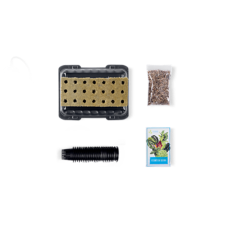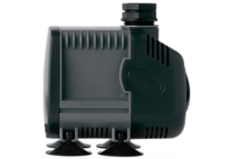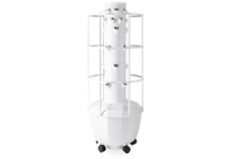Economy Garden: Growing More With Less

Growing your own food is a quick way to cut down on food costs while still enjoying delicious meals. Tower Garden makes it easy for gardeners of all skill levels to grow fresh fruits, vegetables, and herbs practically anywhere.
Not only does growing food with Tower Garden reduce the number of trips needed to the grocery store, but it also improves the quality of the produce you eat, as well. Growers can also take their savings one step further by following our tips in these categories:
- Saving Your Seeds
- Repurposing Your Scraps
- Making Your Harvests Last
Saving Your Seeds
Saving seeds is a great, and rewarding, gardening habit. Not only does the sustainable practice of saving seeds allow you to keep growing your favourite plant varieties for free, but it’s also incredibly easy. Here are tips on saving seeds from various plants.
- Flowers, Greens, Herbs, and Other Plants that Produce Dry Seeds: The seeds of these plants happen to be the easiest to harvest; all it takes is patience. Simply wait until the plants are dry to collect the seeds.
- Tomatoes, Cucumbers, Aubergine, and Squash: The seeds of these larger crops often require fermentation to remove germination-inhibiting substances from the seed coat. Here’s how to successfully ferment seeds of these plants:
- Start with an overripe fruit.
- Put seeds and any surrounding pulp in a jar and cover with water.
- Set the jar in a warm place and stir daily for about three days.
- After rinsing, dry seeds for at least two weeks.
- Melons, Peppers, Pumpkins, and Other Fruit-Bearing Plants: For produce with seeds surrounded by pulp or flesh, simply scoop the seeds out and clean them in a bowl of water. Once you’ve separated the seeds from the pulp, allow them to dry for at least two weeks.
Replant, regrow, repeat!
Making Your Harvests Last
On average, Tower Garden harvests yield 30% more produce than traditional gardening methods. This means that you’ll likely have plenty of greens to use at all times. While it’s best to use produce right after it’s picked from your Tower Garden, there are plenty of ways to preserve your harvests and make them last longer.
Blanching Produce
Before we look at preservation options, let’s touch on blanching—the process of briefly exposing produce to boiling water.
After you harvest, enzymes immediately start affecting produce nutrients, colour, and flavour. If left alone, these enzymes ultimately cause food to spoil. Blanching destroys enzymes, thereby deactivating the decomposition process.
Here’s how to blanch:
- Clean your produce.
- Fill a cooking pot with water and bring it to a boil.
- Add the produce to the pot and blanch for 2–5 minutes.*
- Plunge produce in ice water to preserve colour and flavour, as well as preventing the produce from actually cooking.
*Before you start blanching, check out this list of crop-specific recommended blanching times. Under-blanching stimulates enzymes, and over-blanching can rob produce of colour, flavour, and nutrients.
Drying Herbs and Other Produce
Drying preserves food by removing about 80%–95% of its moisture. It’s important to note, though, that moisture isn’t all that’s removed. Produce may lose more flavour and nutrients when dried rather than, say, frozen.
Harvest your herbs in the morning to preserve the greatest amount of essential oils (the stuff that makes herbs amazing). Harvesting before the plant goes to seed will also help make sure you get the best flavour.
Here are a few ways to dry your harvests for preservation.
- Drying on a Tray - If you have lots of produce to dry, trays offer the benefit of a large surface area. You can put the trays in the sun outside (and cover with cheesecloth to keep bugs off) or in a dry place indoors. If drying outdoors, keep in mind that sunlight can destroy produce nutrients during the drying process.
- Hang Drying - As long as you have the space, hang drying is probably the simplest method for herbs and leafy vegetables. Just gather the produce in small bunches and suspend them from a coatrack or any other reasonably dry place.
- Drying in an Oven - This is one of the fastest drying methods, and it retains much of a food’s nutrients and colour. It’s also the best way to dry more dense foods like tomatoes. To oven dry your harvests, line a baking sheet with parchment paper, spread the produce evenly on a single layer, and set your oven to its lowest setting, ideally 80° C or less. After about an hour, turn each piece over. Repeat this process as necessary until dry.
Freezing Herbs, Vegetables, and Fruits
Most herbs, vegetables, and fruits can be frozen. But since freezing alters produce texture, you might want to use a different method for foods you’d typically eat raw, such as lettuce, tomatoes, or cucumbers.
That said, freezing is the most popular preservation method since it’s simple and effective. After blanching and allowing the produce to dry (this helps prevent ice buildup), just put it in a freezer bag, squeeze the air out to prevent freezer burn, and stick it in your freezer.
Repurposing Your Scraps
Did you know you can repurpose your kitchen scraps to grow more with Tower Garden? Not only does it save money and reduce food waste, there’s also something truly rewarding about upcycling.
For most plants, the process is fairly simple.
Lettuces and Leafy Greens
Before tossing any unwanted leaves, save a few and place them in a bowl with about 1/2 cm of water. Keep the bowl in a kitchen window or somewhere with good sunlight and replenish the water often to keep the level consistent.
In three or four days, you should begin to see small roots and new leaves forming. You can transfer the new growth to a damp rockwool cube and then to your Tower Garden. This process works for many herbs, too, including basil, mint, and others. The only difference is that you’ll want to save the herb’s stem — rather than just a leaf — and place it in water.
Celery
Good news: No one likes to eat the base of a celery stalk, but you can use it to regrow the plant!Cut off the white portion of the celery stalk and set it upright in a dish of water in a sunny spot. Replenish the water daily for about a week, and soon you should see a new, green stalk emerge from the centre of the base. You can then replant the base in your Tower Garden.
Green Onions
This one is super simple, since the roots are already sprouted. Just remove the white end of a green onion, keeping the roots intact, and plant it directly in a damp rockwool cube with the roots facedown.
Keep it moist and in the sun, and you should see new life forming within a few days. When new sprouts appear, you can place the onions in your garden.
Tomatoes, Peppers, and Other Fruiting Plants
You’ve heard of heirloom tomatoes, but did you know you can also technically grow heirloom cucumbers, melons, squash, pumpkins, and peppers?
After you harvest your fully ripened fruiting plants, remove the seeds from the ones that looked especially delicious and healthy by scooping out the pulp and rinsing it under cool water until the seeds separate. Leave the seeds to dry on a paper towel for a few days
.Once they’re completely dried, save them in an envelope until you’re ready to plant, or transfer them to rockwool to begin sprouting.
Beans and Peas
Here, the trick is to let the bean pod overripen on the Tower. Harvest your crop, but leave a few bean pods.
Once those pods begin to brown, remove them from the plant and allow them to dry for at least a week. You can then shell the seeds from the pod for immediate replanting. (If you don’t plan to sow them right away, leave the seeds in the pod until you’re ready.)
We hope you have some fun with these simple ways to save green by saving your greens!


